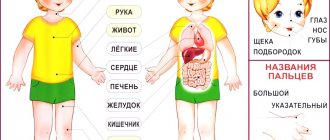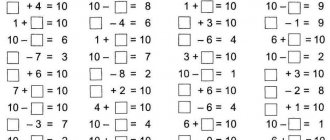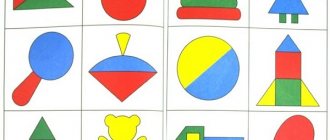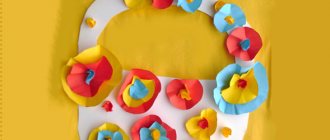This page presents author's books for preschoolers and primary schoolchildren.
Some benefits are offered in full, and some are offered in an introductory version.
All books contain educational tasks for children and are aimed at developing speech, logic, attention, memory, mathematical abilities, fine motor skills, etc.
These books can be downloaded free of charge for personal use.
All rights reserved. Copying with obligatory link to the source!
Olga Naumova “Magic patterns”
Have you noticed that many of natural forms have rounded outlines? This is a snowflake, a starfish, and a spider’s web. They are very harmonious. Therefore, when a hand traces, draws, or colors circles, any person, be it a child or an adult, becomes calmer and more cheerful. Every child will find it interesting and useful to study intricate patterns. By drawing and coloring patterns in a circle, the child not only calms down, but also develops his creative abilities. His attention and memory, his ability to compare and observe improve, he gets used to accuracy and perseverance in his work, and learns to think figuratively.
Download the book by O. Naumov “Magic Patterns”
Consultation for parents “Doing tasks with children at home”
Tatiana Chugunkina
Consultation for parents “Doing tasks with children at home”
Consultation for parents
“Doing tasks with children at home”
All parents dream of a child being healthy, obedient, smart and beautiful. However, children, as a rule, have their own plans in this regard. They do not yet understand that intelligence and knowledge in the modern world are power. And it’s impossible to explain this to them.
So what remains for parents? There may be two options here. Either resign yourself and let everything take its course, or look for tricks and use cunning in order to still instill in your baby such useful skills and abilities.
What is the importance of homework for children in kindergarten?
It is of great importance:
• Children begin to develop a sense of responsibility;
• Awareness that knowledge can be acquired by oneself (at this age, together with parents)
• children develop independent thinking skills;
Recommendations for parents to help them complete tasks with their children.
1. Do not turn the task into an instrument of torture.
It is important to interest the child in the task, tell him interesting facts, ones that will excite him and make him want to share his new knowledge with friends.
2.Form positive motivation for completing the task, its long-term perspective.
If your child refuses to complete tasks, you
• Gently but persistently get the job done.
• Complete tasks in a playful way, imagine a trip, find different motives for completing tasks each time
• Form cognitive interest in children:
1) Invite your child to play a board game, and he will not refuse.
2) You can use the technique with hobbies. Here it is important to understand what the child likes, and then adapt his interest to knowledge. For example, a child loves cars. Great, count them as you walk, combine them by color, etc.
3) Introduce your child to children's literature! Try to read at least a few pages, look at the pictures, ask them to describe them, ask your child questions about the text.
4) Arrange a joint modeling (from plasticine or from salt dough) And start sculpting, you can make a plot-based joint composition on the topic of the task.
5) Can you come up with a story for children in pictures? For example, take a stack of old magazines and cut out pictures from them: people, animals, plants. Then, together with the children, come up with the plot of a fairy tale and stick the pictures on a large sheet of paper. If some characters are missing, you can add them.
6) You can show your child a puppet show or invite him to show you the show himself, or better yet, arrange a joint performance for other family members.
7) Arrange a joint drawing on the topic of the task. Make a book from which the child can then tell others about the knowledge he has acquired.
3. Reward your child for a task well done. It is not acceptable to scold, get angry, or get irritated, otherwise a negative attitude towards completing tasks will be formed.
Educators offer homework not only in order to create and consolidate the child’s emotionally positive attitude towards learning, but also in order to strengthen contact between parents and child, which will help you in the future both at school and simply in life.
Remember that our goal is to teach the child not only to complete tasks,
but also to feel that his parents will always, in any situation, come to his aid, that
His difficulties will be successfully overcome with your help.
4. Don't try to complete the task for your child.
In preschool age, a child most often cannot complete a task on his own; help him cope, but together does not mean instead. Do not exclude the role of the child himself; he must take part in completing the task and, upon positive completion, feel a sense of satisfaction and pride in a well-done task. Praise your child for the slightest success, support him: “I know YOU CAN CANDLE IT,” “YOU WILL DEFINITELY SUCCEED IT.”
WE WISH YOU SUCCESS!
CHILDREN'S SUCCESS IS LIKE A BALM FOR THE HEART,
WHAT COULD BE BETTER FOR LOVING MOMS!
FROM THE FIRST SMILE TO VICTORY, FORWARD!
WE BELIEVE, FAMILY, LUCK IS WAITING FOR YOU!
Olga Naumova “Logic”
The ability to think logically and reason is necessary for a child to successfully study at school - otherwise he may face difficulties in mastering basic subjects. This manual contains exercises that will help a future first-grader master basic skills - recognize objects by given characteristics, compare and find common and distinctive features, generalize, determine patterns and sequence of events, and solve simple logical problems.
Download the book “Logic” by O. Naumov
What should a child entering first grade know?
It often happens that parents, when preparing their child for school, focus on one thing and neglect other aspects of development. Below is an approximate list of knowledge that a 6-7 year old child should have when entering school:
- own surname, first name and patronymic, surname, first name and patronymic of parents, home address, country and city of residence;
- your birthday and the birthdays of your parents;
- days of the week, months, seasons;
- names of common animals and plants;
- primary colors;
- basics of traffic rules;
- professions, sports, names of famous poets and writers;
- major holidays;
- “right” - “left”, “more” - “less”, “older” - “younger”, “long” - “short” and so on;
- how do bodies of water differ (do not confuse rivers with seas);
- what is the difference between shrubs and trees, vegetables and fruits from berries;
- how do sounds differ from letters, vowels from consonants;
- solve simple problems;
- solve logical riddles;
- restore sequence, find similarities and differences in pictures;
- describe the image, retell stories;
- know short poems;
- count to 10 and perform simple arithmetic operations;
- read small sentences (4-5 words), understand what you read;
- cut geometric shapes with scissors;
- draw straight lines without a ruler, hatch without going beyond the outline.
Olga Naumova “Learning to compare”
Preschool children often have difficulty making comparisons. The ability to compare is one of the most important mental operations, which is based on developed speech, logic and observation. Therefore, it is extremely important from early childhood to stimulate the development of logical thinking, attention, and observation in children. Along with these skills, the child’s speech develops and his vocabulary is enriched.
Download the book by O. Naumov “Learning to Compare”
Classes for teaching children 5-6 years old
The “Training” block is aimed at developing and consolidating basic knowledge and skills in the child, which will allow him to more easily adapt to school. The block includes the following topics:
- Mathematics: Section "Counting and numbers"
- Section "Other mathematical representations"
- Section “Preparation for literacy training”
Considering the specifics of the material in this block, the division of tasks within topics into levels of difficulty is very arbitrary. Indeed, it is difficult to say what is more difficult - to learn the number 1 or the number 5, or to master the letter “O” or the letter “W”.
Parents may wonder why a preschooler needs this if all the listed topics are included in the first grade curriculum. This is true. But practice shows that in modern schools children do not have enough time to master all this knowledge “from scratch.” Most modern programs contain a very large amount of information, as a result of which the time for practicing the acquired knowledge is reduced. Therefore, it is better if the child, by the time he enters school, can read and count within ten. This will give him the opportunity to easily adapt to the pace of work in the classroom, make him feel more confident, and reduce the learning load at the stage of adaptation to school. In addition, the game activities offered here in no way duplicate the school curriculum. They are designed for older preschoolers and take into account the developmental characteristics of children of this age. It should also be noted that at the age of 5-6 years, many children themselves show an interest in counting and reading and easily master them with properly organized classes.
Each topic or section includes a certain number of subtopics. Each subtopic has a training part and tasks to test the mastery of the material and consolidate it. The training part is a remote game lesson with an explanation of new things using visual material. Since this is a completely unfamiliar type of activity for a child, we recommend that parents at the initial stage of the child’s work with the block be close to him in order to assess whether the child understands the proposed explanations, whether he is interested, and also to answer questions that arise in a timely manner. If the child does not have time to perceive the material at a given pace (especially when learning letters when reading syllables, words and phrases), use the “pause” button to give the child the opportunity to understand and repeat what is proposed in the explanation. And please show your child how he himself can stop the explanation when he needs to. After the training part, the child is asked to complete several tasks based on the material he has just learned.
Please make sure that your child does not become overtired. One of the advantages of our site is that a child can move through blocks and topics at an individual pace that is comfortable for him, and also return to material already covered.
It is quite possible that your child has already mastered reading and counting. In this case, we suggest that he start working with the block with training tasks. They offer several options to better practice the acquired skills. The difficulty for all options is approximately the same. If the child successfully copes with them, his level of proficiency in counting, reading and basic literacy can be considered more than sufficient.
Dear parents! Please note that during classes the child will need: a piece of not very stiff wire (about 20 cm long), 10 any pencils, plasticine of any color, lace or woolen thread, from which you can cut pieces of the desired size (20-30 cm) .
Patience to you and success to your child! Have fun!
Educational activities for children “Fun Lessons”
Home\About children\Preparing for school\ Educational activities for children “Fun Lessons”
Educational activities for children “Fun Lessons”
There are a lot of activities aimed at developing a child’s thinking and they can easily diversify a child’s leisure time. solving riddles, coloring books, copybooks, and various logic tasks... On this page we have collected a variety of tasks for the diversified development of children from 3 to 7 years old.
Click on the pictures to enlarge them. You can then save the image to your computer and print it for an activity with your child.
Developmental activities for children 3-4 years old
We develop memory, thinking, attention and fine motor skills.
Developmental activities for children 5 years and older
We develop memory, thinking, attention and fine motor skills.
Developmental activities for children 5-6 years old
We develop memory, thinking, attention and fine motor skills.
Comments
#1Katerina07/09/2015 15:56 I found so many useful and interesting things on your site! Thank you!
Link to source www.7gy.ru
Assignment on the lexical topic: “Pisces”
Exercise “Little fish and giant fish.” Formation of word formation skills, the use of nouns with the suffixes -ish, -ishka:
gudgeon - gudgeon - gudgeon ruff - brush - ruff,
shark - sharks fish - fish - fish
crucian carp - crucian carp - crucian carp perch - perch - perch
Guess the riddles. Explain how you guessed what words helped you find the answers.
She lives in water.
There is no beak, but it pecks. (Fish)
It crawls the other way around - backwards. (Cancer)
She is the storm of the seas
Get away from her quickly! (Shark)
Development of sound and letter analysis skills.
Draw or stick 10 fish. Write short words in their entirety, and write the first and last letter of long ones.
For example: catfish - COM, flounder - K________A
Learn a poem with your child. Do finger exercises with him.
Fish
The fish swims in the water, the fish arches its back,
The fish have fun playing. I took a bread crumb.
Fish, fish, mischief, The fish waved its tail,
We want to catch you. The fish quickly swam away.
Top
Why prepare for school
With the arrival of a child in an educational institution, his leading activity changes: there was play, now there is study. And in order to cross this line with the least stress and “losses,” teachers strongly recommend starting preparation for training at least six months before September 1.
Not only the educational moment is important here, but also the psychological one. And if in the usual offline mode, attending preparatory courses, it is easier for a child to understand what awaits him (the mode, appropriate reactions to the actions and words of the teacher, speed, etc.), today this task falls on the shoulders of the parents. Explain, tell and show how it will be.
As for the educational aspect, the resources we offer below will help.
Exercise “The fourth is extra” - name the extra one and explain your choice.
Swallow, wolf, hare, cat (an extra swallow, because it is a bird, and the rest are animals) Starling, dog, cuckoo, nightingale. Sparrow, dove, crane, tit. Rook, swan, duck, crow. “Who are there many in the forest?” There are many starlings in the forest (swallow, nightingale, stork, rook, crane, cuckoo, heron, swift) “Count to 5.” One swallow, two swallows, ...... five swallows. (cuckoo, starling, nightingale, stork, rook, crane, heron) “Name the chicks.” rook - rook... duck -... cuckoo -... starling -
Learn a poem about birds with your child. Do finger exercises with him. (when naming a bird, bend your fingers). A flock of birds Sing, sing, sing along, ten birds - a flock. This bird is a nightingale, this bird is a sparrow. This bird is an owl, a sleepy little head. This bird is a waxwing, this bird is a corncrake. This bird is a little gray feather. This one is a finch, this one is a swift, this one is a cheerful siskin. Well, this is an evil eagle. Birds, birds, go home! Clench your fingers into fists
Top
Assignment on the lexical topic: “Spring”
Learn a poem with your child. Do finger exercises with him.
Exercise "Spring"
Spring has arrived in the snow,
On a damp carpet. They walk with their fingers on the table.
Scattered snowdrops, Hands on the table, palms down.
I sowed grass. Spread - move fingers.
Now he is calling from all over. Arms are bent at the elbows - fingers are open.
Geese, swifts and storks Bend one finger on each hand.
Cuckoos and starlings.
Top









